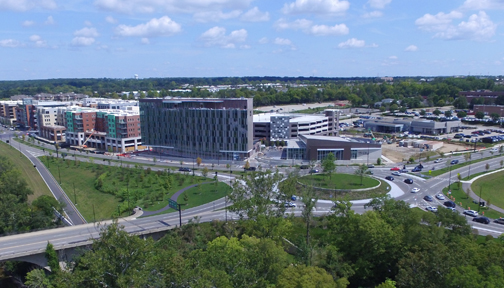
Day by day, adoption of ‘smart’ technology continues to grow, particularly among city governments. In fact, it’s now estimated that the smart city market in North America will reach $5.6 billion by 2025, according to Harbor Research data and analysis by Fujitsu. But for many municipalities, there is a long way to go and many questions to be answered along the way.
Fujitsu is working closely with municipal governments to help them plan, deploy and manage smart networking technologies. Here are a few lessons learned from a recent smart city transformation undertaken by the City of Dublin, Ohio.
Breaking Point or Tipping Point?
In an effort to improve quality of life and access to services for their residents, more and more cities are embracing digital transformation. As they make the transition to online systems, these cities begin to amass large quantities of data generated within various departments. However, too often these datasets become mired in siloes within disparate software systems.
Yet, with the ability to bring these datasets together across multiple systems, cities can obtain complete visibility into all available data and it then becomes economically feasible to digitize and access physical assets in real-time. Digital representation of a city’s assets, such as parking spaces, roads, utilities and fuel consumption, is key to providing better experiences for citizens and businesses, reducing the carbon footprint, improving emergency response capabilities, and reducing operational costs.
For the City of Dublin, lack of visibility was causing congested parking lots and poor parking management, which was impacting local businesses. Fujitsu assisted the city with design and deployment of a private broadband network using the shared Citizens Broadband Radio Service (CBRS) frequency band, along with a smart parking app, as the first phase of a software-defined, 5G-ready platform for digital transformation. As part of the broader Connected Dublin initiative, this pilot is making use of smart mobility technology, IoT infrastructure, edge computing and high-speed fiber connectivity to enable economic development and a better quality of life.
Smart Building Blocks
Beyond deployment of the broadband network, the smart parking application involved building infrastructure to enable connectivity, including wireless radios, base band units (BBUs), surveillance cameras and customer premise equipment installed on utility poles around the parking lot. Video analytics software runs on the Multi-access Edge Computing (MEC) node, while the IoT framework and application software run on the network core.
Importantly, this digital transformation was made economically feasible by the cost-efficiency of shared CBRS spectrum, software virtualization, and low-cost cameras. The low cost of the CBRS band allows service providers to enter the wireless market by building private networks for enterprises and cities. Once the network is in place, whitebox servers provide network function virtualization that can be used to run additional application software for future use cases, such as smart utilities, enhanced security surveillance or e-health services.
For example, now that the City of Dublin network is in place, applications such as Smart Distancing and Smart Masks can be added ‘over the air’ to the network servers to enable COVID-19 compliance measures. In fact, the city has already found that in addition to alleviating parking congestion, the smart parking application has allowed city staff to remotely monitor compliance to COVID-19 “stay at home” guidelines.
Smart Lessons Learned
By deploying IoT technology, analytics and smart apps that enable digital twins of the cities’ assets, the City of Dublin is better equipped to understand their operations, predict the future, and improve decision making and planning processes. But the transition to becoming a smart city doesn’t happen overnight, and there are many steps to be taken. Here are just a few of the lessons learned along the way:
Lesson #1 – Deployment
- Permitting and inspection takes time
- Installation can be costly
- Appearance matters
Lesson #2 – It is all about data
- Automatic data collection is important
- Facilitate a smooth path from data to decision
- Open APIs are a must
Lesson #3 – Environmental challenges
- Plan for rain and snow; storms and high wind
- Trees and leaves will impact line of sight.
Learn more about the City of Dublin smart parking pilot from Ladan Pickering during the SCTE Cable-Tec panel discussion, Industrial IoT – How to Address Challenges in Architecture and Security
Cable-Tec registration is free: https://expo.scte.org/